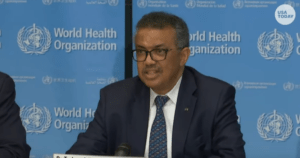The Devils We Know
The initial response to the flu outbreak, which may have the potential to become a pandemic, illustrates first of all how sensitive and responsive the global health-monitoring system has become.Mexico City is one of the greatest urban agglomerations in the world, a dense and teeming mountain valley with a population of more than 20 million. Wealthy enclaves have the sleekness of Manhattan or Beverly Hills, but much of the metropolitan area is gritty and anonymous. It must be an easy place to disappear.
Yet somehow, amid all the chaos and bustle, Mexican health authorities noticed an unusual cluster of deaths — first just a handful, then a few dozen. That observation led to the identification of a new, potentially dangerous strain of influenza, and now governments worldwide are issuing travel advisories, readying stockpiles of medicine, canvassing hospitals for possible cases of “swine flu,” and, of course, telling citizens not to panic.
The initial response to the flu outbreak, which may have the potential to become a pandemic, illustrates first of all how sensitive and responsive the global health-monitoring system has become. If the world is going to be ravaged by an infectious disease, chances are that we’ll see it coming.
The unusual deaths in Mexico City that caused officials to sound the alarm were not, after all, so unusual. It’s expected that people will die of flu during flu season. But it’s not normal for relatively young, healthy adults to die of flu, as was happening. It was a real achievement for authorities to notice a few anomalous deaths and connect the dots.
The reaction to the new flu — which combines genetic material from avian, swine and human influenza viruses — also illustrates how we spend a lot of time worrying about the wrong potential disasters.
Many experts in risk analysis blame this misdirected anxiety on the “dread” factor. The classic example is airplane travel. The idea of dying in a plane crash is so horrible that some people refuse to fly, even when it is pointed out that they are many times more likely to be killed in an accident while driving to the airport.
Likewise, when we as a nation look at the dangers presented by today’s world, our attention is drawn to the most dreadful possibility. When I was growing up, we feared an all-out nuclear exchange with the Soviet Union; we did “duck and cover” drills in elementary school, as if intercontinental ballistic missiles were no match for our sturdy desks. Today, the Russians still have enough nuclear weapons to blow us all to smithereens, but hardly anyone worries about this anymore. We focus, instead, on the possibility of terrorists somehow obtaining a nuclear device and detonating it in an American city.
This means that our foreign policy debate these days centers on unstable Pakistan, which has nukes, and belligerent Iran, which is trying its best to get them. Obviously, that region has to be our most urgent priority. But we also should think about other threats that could potentially cause much greater loss of life than any conceivable terrorist attack — and that loom much closer to home.
The 1918 flu pandemic killed an estimated 50 million people worldwide. There is no evidence that the new strain of swine flu is anywhere near as deadly as the 1918 flu, and in fact the cases identified in the United States thus far have caused only one hospitalization and no deaths. But the reason officials are declaring emergencies and monitoring the spread of the disease so closely is that they know, in tragic detail, what havoc a 1918-style flu would bring.
Several years ago, when avian flu broke out in Asia, I called a few experts in risk analysis for comment, expecting them to say that everyone should just calm down. Instead, they told me that if someone was looking for a legitimate potential disaster to worry about, a deadly flu pandemic would be an excellent choice.
Officials don’t know why the cases of swine flu in the United States seem so much milder than those in Mexico. They do know that the U.S.-Mexico border is no barrier at all, as far as microbes are concerned.
Back when we were ducking and covering in fear of a Soviet attack, the first few cases of a swine flu eruption might have gone undetected. Like most flu outbreaks, this one probably will be contained. In the meantime, I’m going to wash my hands a lot more often than usual.
Eugene Robinson is the 2009 Pulitzer Prize winner for commentary. His e-mail address is eugenerobinson(at)washpost.com.
© 2009, Washington Post Writers Group
Your support matters…Independent journalism is under threat and overshadowed by heavily funded mainstream media.
You can help level the playing field. Become a member.
Your tax-deductible contribution keeps us digging beneath the headlines to give you thought-provoking, investigative reporting and analysis that unearths what's really happening- without compromise.
Give today to support our courageous, independent journalists.






You need to be a supporter to comment.
There are currently no responses to this article.
Be the first to respond.